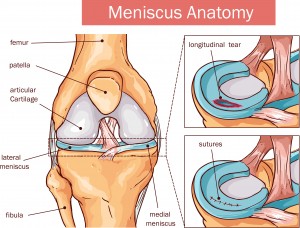What Is a Meniscus Tear?
The meniscus is comprised of two wedges of cartilage (the medial and lateral meniscus), and it cushions the knee joint where the leg bones meet. Your meniscus acts as a shock absorber, allowing the knee to move smoothly. Damage to the meniscus is commonly seen in athletes with twisting injuries. A tear in the meniscus can cause pain and long-lasting damage. Correcting a meniscus tear as soon as possible will help improve your long-term use of the knee.
How Does a Meniscus Tear Occur?
 In athletes, a meniscus tear can occur because of a blow to the knee, over-rotation of the knee, planting a foot awkwardly, or hyperextension of the knee. This can happen in non-athletes as well. Other ways to develop a meniscus injury that aren’t directly related to sports include osteoarthritis, repetitive movements (such as squatting or kneeling), or acute (sudden) injury. In older patients, tears can sometimes develop over time with no known cause.
In athletes, a meniscus tear can occur because of a blow to the knee, over-rotation of the knee, planting a foot awkwardly, or hyperextension of the knee. This can happen in non-athletes as well. Other ways to develop a meniscus injury that aren’t directly related to sports include osteoarthritis, repetitive movements (such as squatting or kneeling), or acute (sudden) injury. In older patients, tears can sometimes develop over time with no known cause.
Symptoms of a Meniscus Tear
- An initial sharp pain or “popping” sensation
- Tenderness along the knee joint line
- Stiffness and/or swelling
- Clicking, popping, catching, or locking of the knee
- Pain when walking down stairs
Types of Meniscal Tears
- Vertical, “bucket-handle tear” – the meniscus tears lengthwise
- Caused when the femur and tibia trap the meniscus when the knee rotates
- Most common in young athletes
- Oblique, “flap tear” or “parrot beak tear” – the meniscus tears where the posterior and middle thirds of the meniscus meet
- Caused by repetitive stress such as running
- Horizontal, “transverse tear” – the inner meniscus margin tears peripherally
- Most common in older patients due to degenerative changes
How to Treat a Meniscus Tear
If you are experiencing any symptoms of a meniscus tear, immediately begin treating with RICE: rest, ice, compression, and elevation. Maintain this treatment for the first 48 hours to decrease pain and minimize inflammation. Ibuprofen or naproxen may be taken for pain management.
The majority of the meniscus has poor blood supply and won’t heal internally. This is why surgery is necessary in many situations. A minimally invasive technique, arthroscopic surgery, can be used to repair the meniscus. An arthroscope can visualize the inside of the knee, and other small tools can fix a torn meniscus by removing or trimming away the damaged portion of cartilage. Occasionally, repairs can be made using sutures or absorbable plastic arrows or staples.
In situations where the cartilage is extensively damaged, a meniscus transplantation may be necessary. However, a limited number of people qualify for this technique. Meniscal transplant candidates:
- Are physically active and under 55 years of age
- Are missing more than 50 percent of their meniscus
- Have persistent pain related to physical activity involving the knee
- Have minimal evidence of arthritis in the damaged knee
Dr. Vangsness is a leading senior orthopedic surgeon at USC. If you need a meniscus tear consultation or have any questions about a previous meniscal surgery, schedule your consultation today. Call us at (323) 442-5800 or contact us online.